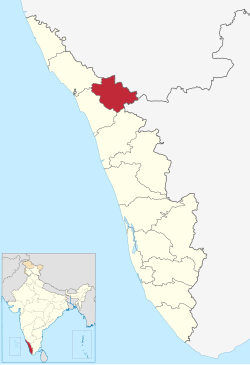
Back واياناد Arabic واياناد ARZ वायनाड जिला Bihari বয়নাড় জেলা Bengali/Bangla Wayanad Catalan Wayanad CEB Wayanad German Distrikto Wayanad Esperanto Distrito de Wayanad Spanish Wayanad barrutia Basque
Wayanad district | |
|---|---|
|
Clockwise from top: Chembra Peak, Wayanad Wildlife Sanctuary, Mall at Sulthan Bathery, Paddy fields, Entrance of Karapuzha Dam, Edakkal Caves | |
| Etymology: Vayal Nadu: land of paddy fields[1] | |
| Motto: "Way Beyond"[2] | |
 Location within Kerala | |
| Coordinates: 11°37′35″N 76°5′20″E / 11.62639°N 76.08889°E | |
| Country | |
| State | Kerala |
| District Formation | 1980 November 1 |
| Headquarters | Kalpetta |
| Sub-division |
|
| Government | |
| • Body | District administration of Wayanad |
| • District Collector | D.R. Meghasree (IAS) |
| • District Police Chief | T. Narayanan IPS |
| • Member of Parliament, Lok Sabha | Priyanka Gandhi Vadra |
| Area | |
• Total | 2,132 km2 (823 sq mi) |
| • Rank | 12th |
| Highest elevation (Vellarimala) | 2,240 m (7,350 ft) |
| Lowest elevation (Chali Puzha, Malappuram border) | 108 m (354 ft) |
| Population (2018)[3] | |
• Total | 846,637 |
| • Density | 397/km2 (1,030/sq mi) |
| Time zone | UTC+05:30 (IST) |
| STD Code | 4936, 4935 |
| ISO 3166 code | IN-KL |
| Vehicle registration | KL-12 Kalpetta, KL-72 Mananthavady, KL-73 Sultan Bathery, KLW (1980–1989)[4] |
| HDI (2005) | |
| Website | wayanad |
Wayanad (Malayalam: [ʋɐjɐnaːɖɨ̆]) is a district in the north-east of the Indian state of Kerala, with its administrative headquarters at the municipality of Kalpetta. It is the only plateau in Kerala.[7] The Wayanad Plateau forms a continuation of the Mysore Plateau, the southern portion of the Deccan Plateau. It is set high in the Western Ghats with altitudes ranging from 700 to 2,100 meters.[8] Vellari Mala, a 2,240 m (7,349 ft) high peak situated on the trijunction of Wayanad, Malappuram, and Kozhikode districts, is the highest point in Wayanad district. The district was formed on 1 November 1980 as the 12th district in Kerala, by carving out areas from Kozhikode and Kannur districts. An area of 885.92 km2 in the district is forested.[9] Wayanad has three municipal towns—Kalpetta, Mananthavady and Sulthan Bathery. There are many indigenous tribes in this area.[10][11] The Kabini River, a tributary of the Kaveri River, originates at Wayanad. Wayanad district, along with the Chaliyar valley in the neighbouring Nilambur (Eastern Eranad region) in Malappuram district, is known for natural gold fields,[12] which are also seen in other parts of the Nilgiri Biosphere Reserve. The Chaliyar river, which is the fourth longest river of Kerala, originates on the Wayanad plateau. The historically important Edakkal Caves are located in Wayanad district.
Wayanad district is bordered by Karnataka (Kodagu, Chamarajanagar and Mysore districts) to the north and north-east, Tamil Nadu (Nilgiris district) to the south-east (it is the only district that shares border with both the neighbouring states of Kerala), Malappuram to the south, Kozhikode to the south-west and Kannur to the north-west.[13] Pulpally in Wayanad boasts the only Lava-Kusha temple in Kerala and Vythiri has the only mirror temple in Kerala, which is a Jain temple. Varambetta mosque is the oldest Muslim mosque of Wayanad. Wayanad is famous for its role in the Cotiote War, where Pazhassi Raja with the help of the Kurichya tribe in association with Hindus and Muslims of the Malabar region launched a revolt against the British. Kaniyambetta and Muttil Panchayaths are the centrally located Panchayaths with the best access from all corners of Wayanad, while Tavinjal Panchayath is on the northeast border with Kannur district. The edicts found in the caves of Ambukuthi Mala are evidence that occupation dates from the beginning of the New Age Civilisation.[14]
- ^ "About District Wayanad". wayanad.gov.in.
- ^ "ABOUT WAYANAD". wayanadtourism.org. Archived from the original on 17 August 2019. Retrieved 31 May 2019.
- ^ Annual Vital Statistics Report – 2018 (PDF). Thiruvananthapuram: Department of Economics and Statistics, Government of Kerala. 2020. p. 55. Archived from the original (PDF) on 2 November 2021. Retrieved 4 April 2024.
- ^ "കെഎല്ഒ, കെല്ടി, കെആര്ഒ... കേരളത്തിലെ പഴയ ട്രാന്സ്പോര്ട്ട് റജിസ്ട്രേഷനുകളും അവയുടെ ജില്ലകളും..." Manorama Online. 8 April 2020.
- ^ "Kerala | UNDP in India". UNDP.
- ^ Poddar, Rakesh (2007). Perspectives on tourism & biodiversity. Cyber Tech Publications. ISBN 9788178842967.
- ^ William Logan (1887). Malabar Manual (Volume-II). Madras Government Press.
- ^ "Topography, Western Ghats, Wayanad, Green Paradise, District, Kerala, India | Kerala Tourism". www.keralatourism.org. Retrieved 7 January 2020.
- ^ "District Profile". spb.kerala.gov.in. Archived from the original on 27 December 2019. Retrieved 7 January 2020.
- ^ "Kerala Tourism". Archived from the original on 20 October 2014. Retrieved 21 June 2012.
- ^ "Tribes in Wayanad". www.wayanad.com. Retrieved 7 January 2020.
- ^ "Mineral Resources in Kerala".
- ^ "Wayanad District Map". Maps of India. Retrieved 7 January 2020.
- ^ "Interesting Facts About Wayanad". 23 December 2016.





